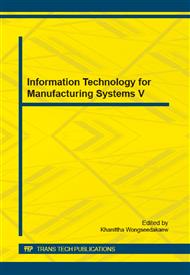[1]
Lottman, R.P. (1982). Report No. NCHRP 48 (3): Predicting moisture-induced damage to asphaltic concrete. University of Idaho, Moscow.
Google Scholar
[2]
Hicks, R.G. (1991). Moisture damage in asphalt concrete, in Proc. Of Transportation Research Board, Washington D C.
Google Scholar
[3]
Kamaitis, Z. (2008). Modeling of corrosion protection for reinforced concrete structures with surface coatings, Journal of Civil Engineering and Management, 14(4), p.241.
DOI: 10.3846/1392-3730.2008.14.23
Google Scholar
[4]
Chadbourn, B.A.; Skok, E.L.; Newcomb, D.E. (2000). Report No. 2000-13: The effect of voids in mineral aggregate on hot-mix asphalt pavement. University of Minnesota, Minnesota.
Google Scholar
[5]
Arambula, E.; Masad, E.; Martin, A.E. (2007). Influence of air void distribution on the moisture susceptibility of asphalt mixes, Journal of. Materials in Civil Engineering , 8, p.655.
DOI: 10.1061/(asce)0899-1561(2007)19:8(655)
Google Scholar
[6]
Kassem, E.A. (2005). Measurement of moisture suction in hot mix asphalt mixes. Master thesis. Texas: Texas A&M University.
Google Scholar
[7]
Kutay, M.E.; Aydilek, A.H. (2007). Dynamic effects on moisture transport in asphalt concrete, Journal of Transportation Engineering , 7, p.406.
DOI: 10.1061/(asce)0733-947x(2007)133:7(406)
Google Scholar
[8]
Cheng, D.X.; Little, D.N.; Lytton, R.L. (2002). Moisture damage evaluation of asphalt mixture by considering both moisture diffusion and repeated load conditions, Transportation Research Record , 1982, p.42.
DOI: 10.3141/1832-06
Google Scholar
[9]
Gorkem, C.; Sengoz, B. (2009). Predicting stripping and moisture induced damage of asphalt concrete prepared with polymer modified bitumen and hydrated lime, Construction and Building Materials , 23, p.2227.
DOI: 10.1016/j.conbuildmat.2008.12.001
Google Scholar
[10]
Aksoy, A.; Tayfur, S.; Ozen, H. (2005). Effect of various additives on the moisture damage sensitivity of asphalt mixtures, Construction and Building Materials , 19, p.11.
DOI: 10.1016/j.conbuildmat.2004.05.003
Google Scholar
[11]
Ministry of Communication. (2000). Standard test methods of bitumen and bituminous mixtures for highway engineering. Beijing.
Google Scholar
[12]
Lamprou, D.A.; Smith, J.R.; Nevell, T.G. (2010). A comparative study of surface energy data from atomic force microscopy and from contact angle goniometry, Applied Surface Science , 256, p.5082.
DOI: 10.1016/j.apsusc.2010.03.064
Google Scholar
[13]
Qian, Z.Y.; Minnikanti, V.S.; Sauer, B.B. (2008). Surface tension of symmetric star polymer melts, Macromolecules , 41, p.5007.
DOI: 10.1021/ma8002888
Google Scholar
[14]
Li, J.J.; Claude, J.; Norena-Franco, L.E.; Seok, S.I. (2008). Electrical energy storage in ferroelectric polymer nanocomposites containing surface-functionalized BaTiO3 nanoparticles, Chemistry of Materials , 20, p.6304.
DOI: 10.1021/cm8021648
Google Scholar
[15]
Terpilowski, K.; Chibowski, E. (2010). Effect of different solid matrixes on surface free energy of EGDMA and TRIM polymers, Applied Surface Science , 256, p.5475.
DOI: 10.1016/j.apsusc.2009.12.143
Google Scholar
[16]
Fu, B.Q.; Liu, W.; Li, Z.L. (2010). Calculation of the surface energy of fcc-metals with the empirical electron surface model, Applied Surface Science , 256, p.6899.
DOI: 10.1016/j.apsusc.2010.04.108
Google Scholar
[17]
Wikimedia Foundation, Inc. 2008[on line], [accessed 7 December 2008] Available from Internet: <http: /en. wikipedia. org/wiki/Wetting>.
Google Scholar
[18]
Khalfallah, S. (2008). Tension stiffening bond modeling of cracked flexural reinforced concrete beams, Journal of Civil Engineering and Management , 14(2), p.131.
DOI: 10.3846/1392-3730.2008.14.8
Google Scholar
[19]
Van Oss, C.J.; Good, R.J.; Chaudhury, M.K. (1988). Additive and nonadditive surface tension components and the interpretation of contact angles, Langmuir, 4, p.884.
DOI: 10.1021/la00082a018
Google Scholar
[20]
Ministry of Communication. (2004) Technical specification for construction of highway asphalt pavements. Beijing.
Google Scholar
[21]
Van Oss, C.J. (1994). Interfacial forces in aqueous media. 1st edition. New York: Marcel Dekker.
Google Scholar
[22]
Van Oss, C.J.; Giese, R.F.; Li, Z. (1992). Determination of contact angles and pore sizes of porous media by column and thin layer wicking, Journal of Adhesion Science and Technology , 6, p.413.
DOI: 10.1163/156856192x00755
Google Scholar
[23]
Washburn, E.W. (1921). The dynamics of capillary flow, Physical Review , 17, p.273.
Google Scholar
[24]
Ran, M.Y.; Chen, J.W. (2000). New proof and discussion on the formula for measuring surface tension by Neumann Method, Journal of Hua-qiao University (Natural Science Edition) , 21, p.172. (in Chinese).
Google Scholar
[25]
Shen, Q.; Hu, J.F.; Gu, Q.F. (2004). Examination of the surface free energy and acid0base properties of cellulose by the column wicking technique and the critical packing height/density, Colloids and Surfaces-A , 240, p.107.
Google Scholar
[26]
Torres, A.C. (2004). Probabilistic analysis of air void structure and its relationship to permeability and moisture damage of hot mix asphalt. Master thesis. Texas: Texas A&M University.
Google Scholar
[27]
Shah, B.D. (2003). Evaluation of moisture damage within asphalt concrete mixes. Master thesis. Texas: Texas A&M University.
Google Scholar


